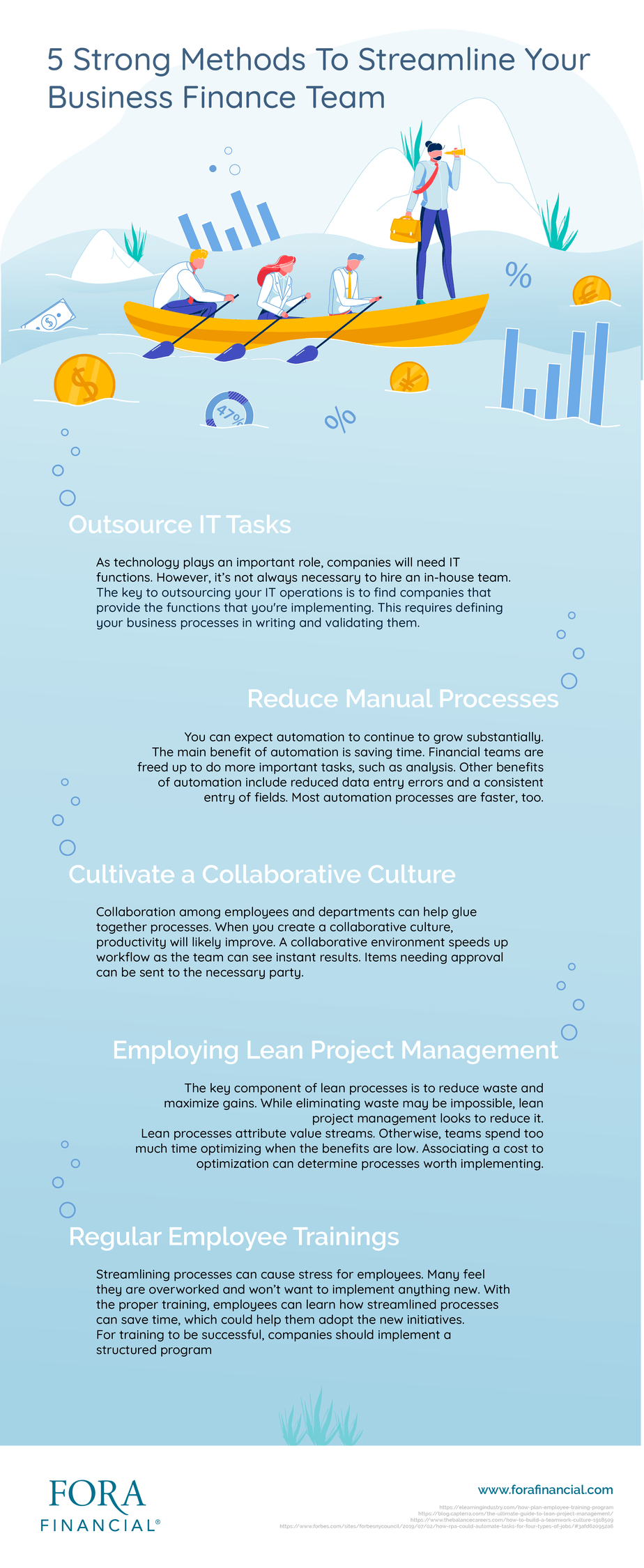January 29, 2020
5 Strong Methods To Streamline Your Business Finance Team
By improving the effectiveness of your business finance team, they can focus on core activities, while management can work towards expansion.


Why Effectiveness in Business Finance Is Key to Success
If your company doesn't have an effective business finance operation, you run the risk that your competitors will. They'll look for advantages, and an effective operation will help them achieve this goal. Technology plays a crucial role in business finance operations. Outsourcing, automation, collaboration, and proper training will all contribute to the success of the business. Finance should never be the bottleneck in the production cycle. Business finance is essential for all operations of a business, not just the core functions. Inventory management, receivables and payables, product development, and marketing are among these functions. Further, a finance team must address any issues concerning audits and external authorities. The team must also report the financial situation of the company to management.How to Streamline Your Business Finance Team
When the business finance team works to streamline its processes, it benefits the entire business. While several functions may help to increase efficiencies of operations, we've identified five ways to get started. An effective operation won’t be beneficial if the people relying on the output don’t know how to implement them. Therefore, training should be a core process to include. Other areas are outsourcing IT, reducing manual processes, cultivating a collaborative culture, and employing lean project management.1. Outsource IT Tasks
As technology plays an important role, companies will need IT functions. However, it’s not always necessary to hire an in-house team. IT is one of the first business functions to use outsourcing. It was controversial at the start but has become acceptable for business. The key to outsourcing your IT operations is to find companies that provide the functions that you're implementing. This requires defining your business processes in writing and validating them. People often think of outsourcing as offsite locations in remote parts of the world. However, companies can provide personnel at your location. These people become an integral part of your on-site operations. The temporary nature of outsourcing can benefit your company, as you can make adjustments when needed. When technology changes, you can look for companies that offer new technologies.
2. Reduce Manual Processes
You can expect automation to continue to grow substantially, for both businesses and individuals. Companies are investing heavily in robotics and artificial intelligence. This investment will lead to considerable reductions in manual processes. Small business owners can take advantage of AI technologies. Several providers offer cloud AI services, such as Microsoft, Google, Amazon, and IBM.More will likely follow. Like most cloud services, business owners can pay for only what they use. They don’t have to invest in hardware or software to run automation. The main benefit of automation is saving time. Financial teams are freed up to do more important tasks, such as analysis. Other benefits of automation include reduced data entry errors and a consistent entry of fields. Most automation processes are faster, too. Not every process is eligible for automation. Processes that are straightforward, without a lot of exceptions, are prime candidates.3. Cultivate A Collaborative Culture
Collaboration among employees and departments can help glue together processes. Software tools and the cloud are a great help to implement a collaborative environment. However, employee and management mindset will be a significant factor in its success. Collaboration requires an implementation plan. Part of that plan should include incentives to help internal teams work together. Employee feedback is critical for this plan, too. Without it, many employees will resist change. Cloud-based software is growing in popularity, which could help the collaborative initiative. Many employees are familiar with the concept with the software they may already be using. When you create a collaborative culture, productivity will likely improve. A collaborative environment speeds up workflow as the team can see instant results. Items needing approval can be sent to the necessary party. Managers can follow up with approvers if a preset time passes.4. Employing Lean Project Management
Lean project management derived from lean manufacturing. After World War II, Japan had limited resources and needed to find ways to work with the resources they had. The Toyota Motor Company produced the Toyota Production System (TPS), which is the basis for lean manufacturing. The success of TPS has led to lean processes in other areas, such as project management. The key component of lean processes is to reduce waste and maximize gains. A critical factor when implementing any lean procedures is to become obsessive about waste. While eliminating waste may be impossible, lean project management looks to reduce it. It’s a continuous process and one that should be evaluated. Lean processes attribute value streams. Otherwise, teams spend too much time optimizing when the benefits are low. Associating a cost to optimization can determine processes worth implementing.5. Regular Employee Trainings
Streamlining processes can cause stress for employees. Many feel they are overworked and won’t want to implement anything new. With the proper training, employees can learn how streamlined processes can save time, which could help them adopt the new initiatives. For training to be successful, companies should implement a structured program. The program should be relevant to the employees and departments. The credit department shouldn't go through inventory management training unless it plays a role in their jobs. The training should also be timely. If you try to train someone today on skills they won't use for another two months, they’ll need retraining. On the job training can help to reduce this issue. It pays for companies to measure the success of their training programs. They can keep what works and change or scrap what is less effective. This will help future employees train faster.